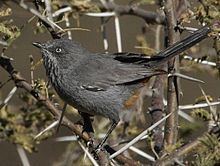Class Aves Scientific name Sylvia subcaerulea | Phylum Chordata Order Passeriformes Genus Sylvia Rank Species | |
 | ||
Similar Layard's warbler, Yemen warbler, Brown parisoma, Banded parisoma, Long‑billed crombec | ||
The chestnut-vented warbler, chestnut-vented tit-babbler or rufous-vented warbler, (Sylvia subcaerulea), is an Old World warbler.
Contents
The chestnut-vented warbler breeds in southern Africa in Angola, Botswana, Zimbabwe, Zambia, Namibia, South Africa, Lesotho, Mozambique and Swaziland. This is a common species found in a range of habitats fynbos, scrub, thickets and dry riverbeds.
Taxonomy
The first formal description of the chestnut-vented warbler was by the French naturalist Louis Jean Pierre Vieillot in 1817. He introduced the binomial name Sylvia subcœrulea using the œ ligature. The specific epithet would normally be spelled subcaerulea or subcærulea and comes from the Latin sub meaning somewhat or beneath and caeruleus for blue. In modern Latin subcaeruleus is used to indicate pale blue. Most authorities use the standard spelling subcaerulea but some use the original spelling subcoerulea.
Description
The chestnut-vented warbler is 14–15 cm long and weighs around 16 g. Its upperparts are grey-brown, and the tail is black with a broad white band at its tip. This warbler has a white eye ring. The throat is grey with heavy dark streaking, the breast and belly are grey, and the vent area is bright chestnut. The legs are black and the eyes are grey. The sexes are similar, but the juvenile has an unstreaked throat. The call is a loud fluted cheerup-chee-chee.
Layard's warbler, Sylvia layardi, is the only similar species, but is paler, has more white in the tail, and lacks the chestnut vent.
Behaviour
The chestnut-vented warbler builds a cup nest flow in vegetation. This species is monogamous, pairing for life. It is usually seen alone or in pairs, moving through vegetation as it forages for insects and other small invertebrates.
Conservation status
This common species has a large range, with an estimated extent of 2,800,000 km2. The population size is believed to be large, and the species is not believed to approach the thresholds for the population decline criterion of the IUCN Red List (i.e. declining more than 30% in ten years or three generations). For these reasons, the species is evaluated as Least Concern.
